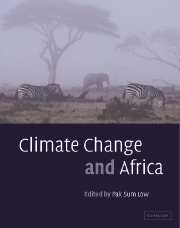Book contents
- Frontmatter
- Contents
- Notes on contributors
- Peer reviewers
- Editor's note
- Foreword
- Foreword
- Foreword
- Foreword
- Preface
- Preface
- Preface
- Preface
- List of abbreviations
- List of SI prefixes
- List of unit abbreviations
- List of chemical formulae
- Part I Science
- 1 Holocene climatic, hydrological and environmental oscillations in the tropics with special reference to Africa
- 2 The relative importance of the different forcings on the environment in Ethiopia during the Holocene
- 3 Global warming and African climate change: a reassessment
- 4 Interactions of desertification and climate in Africa
- 5 Africa's climate observed: perspectives on monitoring and management of floods, drought and desertification
- 6 Atmospheric chemistry in the tropics
- 7 Natural and human-induced biomass burning in Africa: an important source for volatile organic compounds in the troposphere
- 8 Biomass burning in Africa: role in atmospheric change and opportunities for emission mitigation
- 9 Soil micro-organisms as controllers of trace gas emissions over southern Africa
- Part II Sustainable energy development, mitigation and policy
- Part III Vulnerability and adaptation
- Part IV Capacity-building
- Part V Lessons from the Montreal Protocol
- Index
8 - Biomass burning in Africa: role in atmospheric change and opportunities for emission mitigation
Published online by Cambridge University Press: 10 December 2009
- Frontmatter
- Contents
- Notes on contributors
- Peer reviewers
- Editor's note
- Foreword
- Foreword
- Foreword
- Foreword
- Preface
- Preface
- Preface
- Preface
- List of abbreviations
- List of SI prefixes
- List of unit abbreviations
- List of chemical formulae
- Part I Science
- 1 Holocene climatic, hydrological and environmental oscillations in the tropics with special reference to Africa
- 2 The relative importance of the different forcings on the environment in Ethiopia during the Holocene
- 3 Global warming and African climate change: a reassessment
- 4 Interactions of desertification and climate in Africa
- 5 Africa's climate observed: perspectives on monitoring and management of floods, drought and desertification
- 6 Atmospheric chemistry in the tropics
- 7 Natural and human-induced biomass burning in Africa: an important source for volatile organic compounds in the troposphere
- 8 Biomass burning in Africa: role in atmospheric change and opportunities for emission mitigation
- 9 Soil micro-organisms as controllers of trace gas emissions over southern Africa
- Part II Sustainable energy development, mitigation and policy
- Part III Vulnerability and adaptation
- Part IV Capacity-building
- Part V Lessons from the Montreal Protocol
- Index
Summary
Keywords
Biomass burning; greenhouse gas emissions; emission mitigation
Abstarct
A review of available literature published on biomass burning and trace gas emissions in Africa reveals household biofuel use, land use and land-use change to be the most important trace gas emission sources in Africa, contributing about 4% to the overall global CO2 budget. This may not be significant in so far as altering global climate through temperature rise is concerned. However, through the contribution of about 35% of the global photochemical ozone formation, biomass burning in Africa significantly influences important atmospheric processes. Although the total greenhouse gas emissions from Africa are very low compared to those of other continents, countries on the continent could still contribute to global greenhouse gas mitigation efforts through ways that could simultaneously deliver urgent development needs.
INTRODUCTION
Many African governments have for long underplayed their countries' contribution to regional and global greenhouse gas (GHG) emission levels. The general assumption that their countries contribute insignificant amounts of these gases – responsible for the earth's warming – has influenced their hard stance, witnessed at international negotiations, against any meaningful roles in concerted efforts to mitigate GHG emissions. But intensive atmospheric research work on Africa over the past two decades (e. g., SAFARI 2000, www.safari2000.org) have confirmed the significant contribution that biomass burning has made to the regional and global tropospheric trace gas budgets. The land-use and energy sectors dominate African GHG emissions (UNEP, 1998).
- Type
- Chapter
- Information
- Climate Change and Africa , pp. 79 - 89Publisher: Cambridge University PressPrint publication year: 2005
- 5
- Cited by



